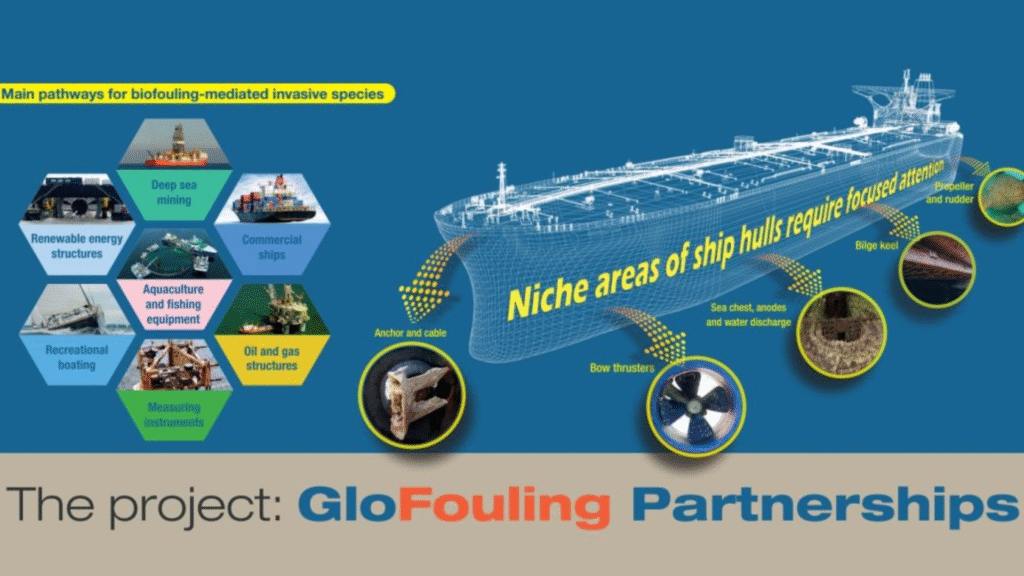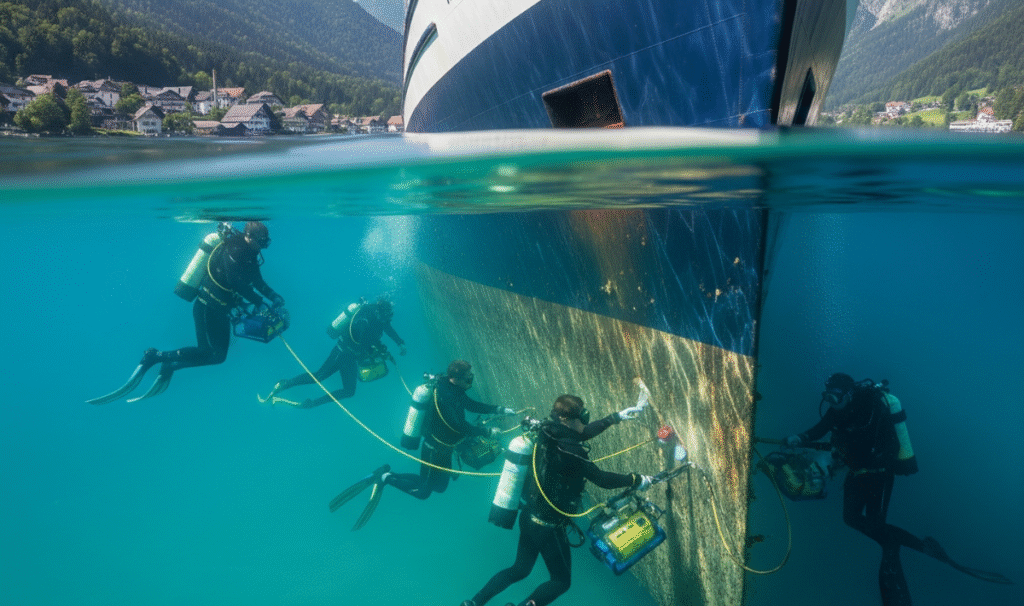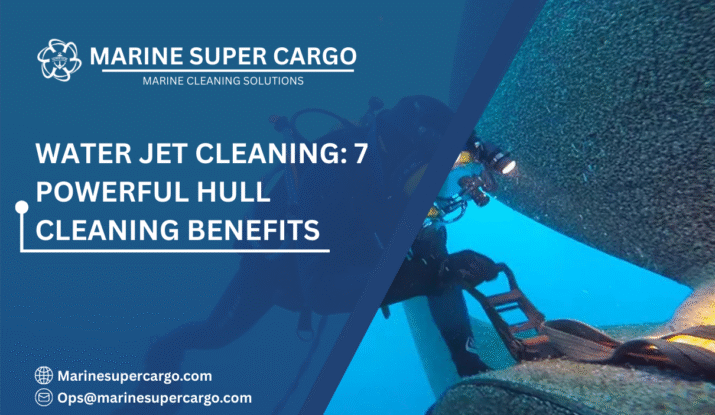Imagine you’re washing your car. A soft sponge can remove some dirt, but when mud clings stubbornly to the tires or undercarriage, only a blast from a pressure washer gets the job done efficiently. Now, take that principle and scale it to the size of a Panamax or VLCC tanker, working underwater, and you’ve entered the world of Water Jet Cleaning—a high-powered solution revolutionizing hull maintenance.
For decades, ship operators leaned on brushes, scrapers, and divers to keep hulls clear of fouling. While functional in their time, these tools are becoming outdated in a world where compliance, efficiency, and sustainability are no longer optional—they are mandatory for survival. That’s where high-pressure Water Jet Cleaning systems come in, offering a cleaner, safer, and more environmentally responsible path to hull care.
Why Hull Cleaning Matters More Than Ever
Biofouling—the buildup of slime, algae, barnacles, and mussels—has been dubbed the “energy thief” of the marine world. Even a thin layer of slime increases drag by about 20%. If barnacles accumulate unchecked, fuel consumption can shoot up by more than 40%.
Why that matters to you:
- Fuel Costs: A fouled hull is a cash drain. For mid-sized vessels, biofouling can mean hundreds of thousands of dollars in extra fuel annually.
- Greenhouse Gas Emissions: With IMO’s decarbonization goals, every unnecessary ton of CO₂ counts.
- Structural Health: Fouling organisms burrow, trap moisture, and speed up corrosion.
- Compliance: IMO, MARPOL, and IAPH rules emphasize clean hulls to prevent invasive species spread.
The question isn’t whether to clean—but how to clean. Traditional methods are now being outpaced by smarter alternatives like Water Jet Cleaning.

What is Water Jet Cleaning?
Simply put, Water Jet Cleaning uses ultra-high-pressure streams of water to blast fouling organisms off a ship’s hull. Pressure settings typically range from 2,000 to 40,000 psi (pounds per square inch), depending on the fouling type and hull coating.
Instead of scraping or brushing with abrasive force, water jets apply targeted hydraulic power. When combined with capture and filtration systems, water jet cleaning ensures that removed organisms and debris don’t simply float off into the sea, where they can spread and colonize new ecosystems.
Think of it as the “surgical strike” of hull maintenance—fast, precise, consistent, and far less destructive to protective coatings.
How Water Jet Cleaning Works
- Deployment
Cleaning rigs—either diver-operated or robotic crawlers—are positioned at the hull. - Water Jet Application
Jets spray ultra-pressurized seawater to strip away slime, weeds, barnacles, and mussels. - Containment & Filtration
In advanced systems, fouling fragments are vacuumed, filtered, and prevented from entering surrounding waters. - Inspection & Reporting
Many setups include cameras and sensors, delivering real-time images of hull condition to operators.
The biggest advantage? Operators can calibrate the jet force. Gentle for delicate coatings, aggressive for heavy fouling—without relying on brute diver labor.
Read also: Underwater Ship Hull Cleaning in Ecuador.
Benefits of Water Jet Cleaning
Switching to high-pressure Water Jet Cleaning allows ship operators and managers to solve multiple pain points at once:
1. Environmental Compliance
By combining water jets with waste capture, ships align with IMO Biofouling Guidelines and MARPOL Annex V prohibitions on harmful discharges.
2. Fuel & Cost Savings
Cleaner hulls mean vessels consume up to 15% less fuel. That’s not only money saved but emissions reduced.
3. Coating Preservation
Unlike brushes or scrapers that can gouge and strip, tuned jets remove fouling while protecting expensive coatings.
4. Worker Safety
Automation and remote operation minimize risky diver exposure to low-visibility harbor waters.
5. Faster Operations
Robotic jet cleaning systems often cover large surfaces in record time, reducing port downtime.
6. Reduced Refouling
Because coatings remain intact, fouling doesn’t return as quickly, extending cleaning intervals.
7. Reputation Safeguard
Adopting cutting-edge sustainability-focused methods positions you as a forward-thinking operator, winning trust from regulators, clients, and partners.
Risks and Drawbacks
Of course, no method is perfect—even Water Jet Cleaning faces challenges:
- Upfront Costs: Equipment is pricier than traditional diver cleaning alternatives.
- Training Needs: Operators must calibrate jets appropriately to avoid coating damage.
- Containment Gaps: Without proper systems, fouling organisms can still escape.
- Port Regulations: Some authorities demand proof of compliant waste filtration.
That said, the long-term return on investment makes these barriers increasingly easy to overcome.
From the Montreal Protocol on Ozone to the Paris Agreement on climate, and to the Minamata Convention on mercury, multilateral agreements unite countries to protect people and planet.
— UN Environment Programme (@UNEP) August 13, 2025
Now, #INC5 aims to add another milestone: a #PlasticsTreaty.
Explore more:… pic.twitter.com/aCS45SaH7X
Comparing Methods: Old vs. New
| Factor | Diver Hull Cleaning (Brushes & Scrapers) | High-Pressure Water Jet Cleaning |
|---|---|---|
| Tools | Wire brushes, hand scrapers | High-pressure water jets |
| Hull Impact | High coating damage risk | Minimal with proper calibration |
| Waste Management | Often uncontrolled release | Containment & filtration capable |
| Safety | Diver-dependent, high risk | Safer, often automated/robotic |
| Compliance | Increasingly restricted | Meets IMO & MARPOL standards |
| Cost | Low upfront, high long-term costs | Higher upfront, lower lifecycle |
| Fuel Savings | Short-lived benefits | Sustained, significant benefits |
Real-World Examples
- Singapore: With strict anti-discharge laws, operators rely heavily on robotic water jet units equipped with waste containment, achieving cleaner hulls and cutting turnaround times by 20%.
- Australia & New Zealand: Ports restricted diver scraping to protect fragile marine biodiversity. Shipping firms adopting Water Jet Cleaning reported not only compliance success but smoother voyages with measurable fuel efficiency gains.
- Europe: Trials with AI-driven jet calibration reduced coating wear by 30%, proving how technology can push performance beyond traditional limits.
Cost Analysis: The Bigger Picture
Let’s break it down:
- Traditional diver cleaning session = ~$10,000, plus risk of coating damage ($50,000–100,000 per repaint), risk of fines for biofouling release ($20,000+), and up to $200,000 in fuel loss annually.
- Water Jet Cleaning session = ~$25,000–40,000. Protects coatings, saves potentially $150,000+ per year in fuel, and eliminates regulatory penalties.
In practice, what seems “expensive upfront” becomes a highly profitable strategy over a ship’s lifecycle.
Compliance in Focus
Global authorities are closing the loopholes:
- IMO Biofouling Guidelines (2011/2020 updates): Require ships to manage fouling with approved, environmentally safe methods.
- MARPOL Annex V: Bans the discharge of pollutants, including fouling debris, without proper handling.
- IMCA: Publishes reliability and diver safety standards, reinforcing the need for low-risk cleaning technologies.
- IAPH: Actively promotes responsible in-water cleaning policies across major ports.
The takeaway? Compliance isn’t optional—it’s an operating license.

Future of Hull Cleaning
As shipping embraces digitalization and sustainability, Water Jet Cleaning will evolve further:
- AI-Powered Calibration: Systems adjust jet pressure automatically based on hull condition.
- Autonomous Drones: Robots map, clean, and monitor hulls entirely hands-free.
- Smart Coating Integration: Jets designed to work with nanotech antifouling paints.
- Eco-Bay Facilities: Designated port stations offering zero-contamination water jet services worldwide.
The global shift isn’t just technological; it’s cultural. Sustainability has gone from “good PR” to a baseline expectation in maritime operations.
Read also: Underwater hull cleaning in the UK
Conclusion
The days of divers with brushes and scrapers dominating hull cleaning are fading. High-pressure Water Jet Cleaning is steering the industry toward a safer, greener, and more cost-effective future. To remember:
- It cuts fuel use, emissions, and compliance risks by protecting coatings and preventing invasive species spread.
- Though upfront costs are higher, the lifecycle savings in fuel and maintenance are substantial.
- Global regulators are pushing shipping firmly toward these eco-responsible solutions.
For modern fleets, the right choice is clear: embrace smarter solutions like Water Jet Cleaning. To explore reliable, compliant practices that balance efficiency with environmental care, visit CleanShip.co.
FAQ:
Q1. What is Water Jet Cleaning in shipping?
It’s the use of ultra-high-pressure water streams, often via robotic crawlers, to blast away fouling organisms from ship hulls without damaging antifouling coatings.
Q2. How does Water Jet Cleaning save money?
By reducing drag, ships cut fuel use by up to 15%, avoid coating repairs, and minimize regulatory fines—savings that quickly outweigh upfront costs.
Q3. Do all ports allow Water Jet Cleaning?
Most ports support it, but many require containment systems to capture removed biofouling. Always check local regulations beforehand.
Q4. Can Water Jet Cleaning damage hull coatings?
When applied correctly, no. Calibrated jets clean effectively while maintaining the integrity of expensive paint coatings.
Q5. What lies ahead for hull cleaning?
Expect autonomous robotic units, AI-driven jets, and eco-station cleaning bays worldwide. The shipping industry is moving toward safer, greener operations at scale.


